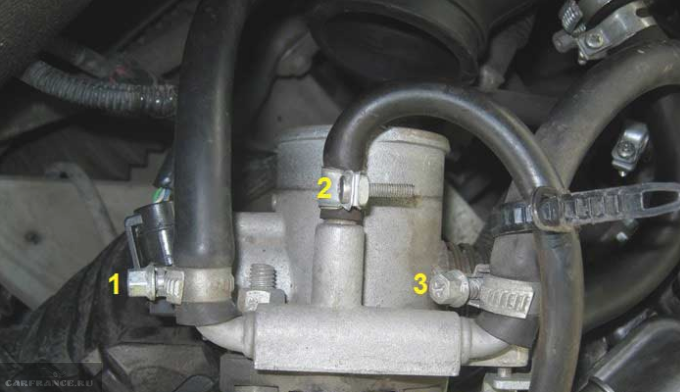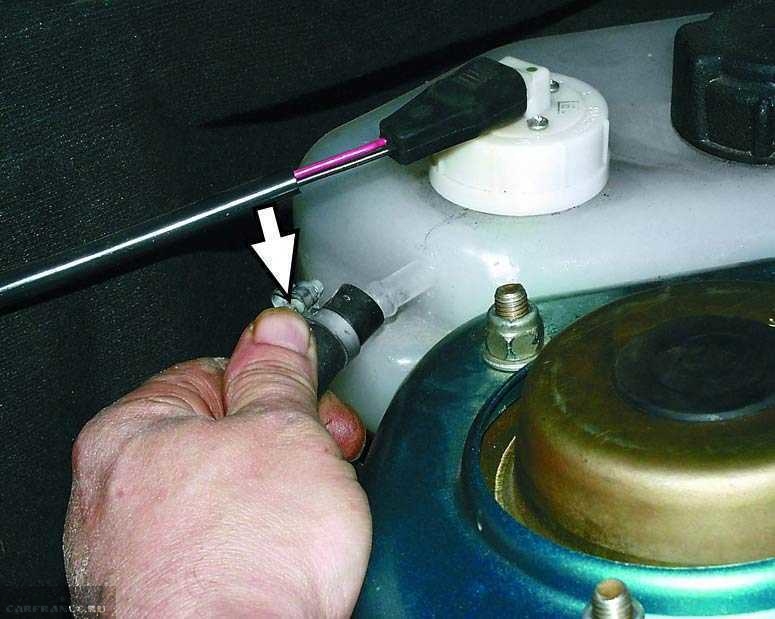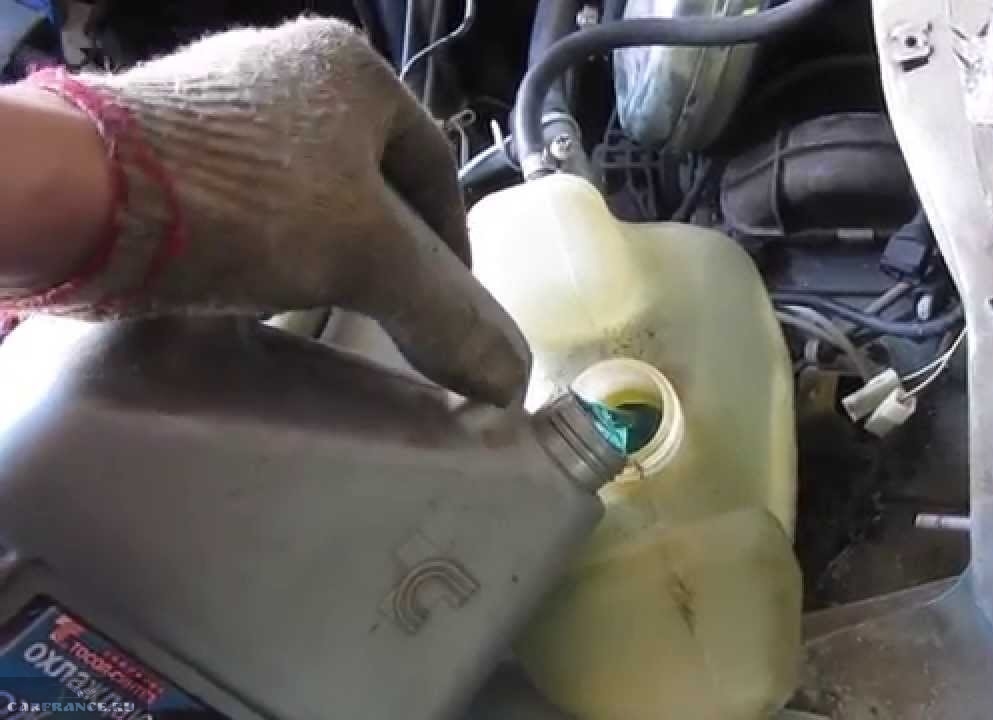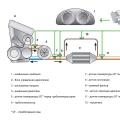Greetings to you friends on the do-it-yourself car repair site. The main task of the cooling system is to reduce the temperature of the main parts of the power unit, gases and oil as quickly as possible, as well as to protect the engine from overheating.
Cooling fluid (antifreeze, antifreeze) passes through special channels, taking heat and cooling in the system radiator. But the efficiency of the system can be compromised if there is an air lock in the cooling system.
In today's article we will look at different wayshow to expel air from the cooling system, as well as the causes and malfunctions of air congestion.
Causes and symptoms of malfunction
Air congestion is a common problem for experienced car enthusiastswhich you have to deal with very often. But before you expel air from the cooling system, it is advisable to still know the cause of the malfunction.
There are several of them:
- Errors when adding coolant or replacing it.
- Suction at the joints of the pipes.
Similar problems in 90% of cases arise in winter, when the chokes are reduced in size under the influence of low temperatures.
As a result, microcracks or other types of damage appear, through which excess air seeps;
- Defective atmospheric valve;
- depressurization of the pump;
- the appearance of a leak in radiators (cooling or heating);
- damage to the gasket under the head of the BC (appears white smoke of exhaust pipe, oil leakage from under the cylinder head becomes noticeable);
- failure of the thermostat;
- mechanical defects or clogging of radiators (connecting pipes).
The presence of an airlock in the cooling system can be easily diagnosed, the engine takes a long time to warm up or, on the contrary, does not reach the required temperature at all.
The explanation is simple. Due to strong airiness, antifreeze (antifreeze) cannot normally get into cooling radiator ... As a result, the engine temperature rises continuously.
The consequences can be disastrous, especially in winter. The heater (stove) does not work. In this case, the coolant no longer enters the heater radiator and, as a result, it does not warm up.
In any of the above cases, it may be necessary to remove air from the cooling system. But how to do it right?
Three methods to expel air from the cooling system
Let's look at the main and most effective ways to solve the problem.
Method number 1... Proceed in the following sequence:
Remove the plastic shroud that is installed on the engine. To do this, it will be necessary to unscrew the cap on the oil filling hole. After that, remove the cover (as soon as the cover was removed, the cover can be returned to its place in order to prevent dirt and dust from getting inside the power unit).
Find the pipes that are responsible for heating the throttle assembly. ( see Cleaning the Throttle BodySelect any and shrink it. Unscrew the cap from the hole in the expansion tank, which contains the antifreeze, and cover the hole with a clean rag.
Blow inside the tank. In this way, pressure is created, which squeezes out the air. As soon as coolant came out of the pipe, you successfully got rid of the air.
Replace the tube (the sooner you do this, the better). Otherwise, you can catch a portion of air again.
Method number 2. This option is much simpler and you don't need to blow anywhere. Expel air as follows:
- Warm up the engine for 10-15 minutes and then turn it off;
- the cap on the expansion tank remains twisted;
- also (as in the previous method) remove one of the nozzles on the throttle assembly;
- wait until coolant comes out of it.
As soon as this happens, immediately return the tube to its place and secure it tightly with a clamp.
When performing this operation, be very careful, because the temperature of antifreeze (antifreeze) can reach 80-90 degrees Celsius.
Method number 3. It is impossible to mention one more simple, but very effective method getting rid of airiness in the cooling system.
Proceed like this:
- Find a steep hill and stand on it in such a way that the front of the car is the highest point;
- put the car on the handbrake and place wheel stands to prevent accidental rolling;
- twist the plugs from the radiator and expansion tank;
- start the car and let it warm up for 10-15 minutes;
- periodically press the accelerator pedal and add coolant to the reservoir as needed.
Refill until no bubbles appear at all. Only in this case can the work be considered completed.
Now you know how to remove airlock from the cooling system quickly and without special financial costs.
At first glance, this problem looks insignificant, but in the end it can lead to a number of problems.
So when the first symptoms of airiness appear, ruthlessly expel the air locks and open normal access for the circulation of the coolant.
Instructions
Make sure the cooling system is tight. Obviously, air in it cannot appear just like that: this is either a consequence of the fact that the coolant was poured during replacement not according to the rules for the operation of your car, or a sure sign that a hole has appeared in the system through which the coolant flows out, giving way to air ...
First, it is worth checking if the drain plug of the cooling system is tightly tightened. If everything is in order with her, you should carefully examine the housing of the expansion tank and look for cracks in the plastic. The next weak link is the actual hoses that unite the entire cooling system: the rubber could dry out and crack from excessively long use or its aggressive conditions.
In the worst case, you may find that air is entering the system due to a leaky radiator or cylinder head gasket.
When you are convinced that the system is sealed, and your efforts will not be wasted, get to work.
Raise the front of the vehicle. You can try to park it safely with the front wheels on any hill, or raise the front of the car with a couple of jacks. This must be done so that the air bleed screw located on the radiator becomes the highest point of the cooling system, and the air flows out there without hindrance.
Open the heater tap. In order to do this, you just need to put the stove control knobs in the extreme position, as if you wanted to warm up the interior. Set also the intensity of the blowing, if your stove model provides this, to the middle position.
Unscrew the cover of the expansion tank and remove the screw to remove air from the cooling system.
Start the engine and let the car run for a while. idling, until the engine warms up and the thermostat and engine rpm values \u200b\u200breach the operating values.
Ask your assistant to drive your car. In order to get rid of unwanted air in the cooling system, it is necessary to periodically press the gas pedal several times and increase the engine speed to allow the coolant to run throughout the system. In the meantime, you will add liquid flowing from the system to the expansion tank and watch if air bubbles have disappeared from it.
Also ask your partner to observe the operation of the stove: if, after several presses on the gas pedal, idle it will begin to stably perform its functions, that is, to supply hot air to the cabin, consider that your mission is completed.
Replace the bleed screw and allow the vehicle to quietly idle for a few more minutes.
Fill the expansion tank with coolant until the level reaches the maximum, then close the tank cap tightly.
Let the car run for another minute. Make sure all caps and plugs are tight and stop the engine.
Tip 2: How to remove an air lock in the cooling system
To fix a problem in an old car, you just need to put it upside down. When working with modern cars, you need to depressurize the cooling system by loosening the pipe on the stove radiator fitting, ensuring the antifreeze is released along with the air.
You will need
- - partner;
- - overpass;
- - clean cloth;
- - coolant;
- - key.
Instructions
An airlock in the cooling system of the "iron horse" can cause many malfunctions, such as engine malfunction, bubbling, overheating of units, incorrect sensor readings, poor interior heating, thermostat failure and others. But before proceeding with the elimination of this problem, it is necessary to exclude other, more serious reasons that could lead to the failure of the car's cooling system. We are talking about mechanical kinks and clogging of the system itself, scrolling, deformation or breakage of the impeller on the shaft, reduced pump performance, incomplete opening of the thermostat, and others.
The process of removing the plug depends a lot on the make of the car. As a rule, there is a special screw plug on the branch pipe that leads to the stove. If you start the engine with the plug slightly unscrewed, then air will begin to escape from the system. But the problem is that this is difficult to do on an old car. Therefore, you can try to remove the airlock through the highest point of the cooling system. To do this, the car must be installed on the overpass with its nose up and the engine turned on. After a while, the plug will come out through the radiator.
To achieve this effect when working with modern cars, it is not enough just to install it on the flyover with the nose up. It is also necessary to break the sealing of the system. To do this, the outlet pipe on the stove radiator fitting is weakened until the pouring antifreeze does not contain air bubbles.
You can go another way: remove the plastic screen from the engine, release the clamp and remove any tube from the heating of the throttle assembly. Unscrew the cap of the expansion tank, cover the neck with a clean cloth and blow so that antifreeze flows out of the disconnected tube. The final step is to quickly put the tube on the fitting and tighten the clamp. Then the plastic screen can be replaced.
You can try to remove the airlock using a universal method: for this, the car must be installed with its nose up, add coolant to the upper mark of the expansion tank, unscrew the screw on the radiator and turn on the stove in the cabin to the maximum. One person should get behind the wheel and periodically gas slightly, waiting for hot air to come out of the stove. The second one is to drain the liquid until it stops bubbling. Only then can the missing volume of liquid be added to the tank and the cap screwed on.
Before proceeding with the elimination of this problem, it is necessary to make sure that there is no mechanical bending and clogging of the system itself, scrolling, deformation or breakage of the impeller on the shaft.
ICE cooling systems can be divided into two types - air and liquid. The most common liquid, although it is more correct to call it mixed. And she, like any mechanism, breaks down from time to time.

Any engine internal combustion Is a source of enormous amounts of heat. But with excessive heating, the metal expands. Besides, air-fuel mixture evaporates quickly or ignites spontaneously. To prevent this, a cooling system is used, which is liquid and air. For the most part modern cars implemented fluid system... True, it would be more correct to call it combined, since there is forced airflow of the radiator with an electric fan.
When the engine is running, it drives a pump that creates fluid pressure. The latter circulates in two circles - small and large. All elements participate in the small circle, except for the radiator. Switching between circles occurs using a thermostat, which is triggered at a certain temperature. But it happens that minor and major breakdowns occur. It is necessary for every driver to know the main symptoms by which you can quickly identify the malfunction and fix it.
Broken thermostat
A thermostat is required to warm up the engine to operating temperature. Therefore, in the default position, it will circulate the liquid in a small cooling circle. In this position, jamming of the mechanism most often occurs. From this it follows that the liquid does not enter the radiator, it does not cool well, therefore it boils.
If there is a problem with the thermostat on the road, you can revive it, however, achieve correct work will not work. Light tapping on the case can make the mechanism work. But the effect of such actions is very small, it will be much better to remove the insides from the case. This will circulate the a large circle, engine overheating will be excluded. But you need to remove the thermostat on a cold engine, after draining the coolant.
Broken expansion tank
When heated, the liquid expands and it needs to go somewhere. The expansion tank acts as such a "transshipment point". All excess coolant goes into it when heated, and when it cools, it returns to the system. It is not uncommon for cracks to form on the tank. They can appear from friction against body elements, from negligence (accidental impact).
But more often the tank lid breaks down. It contains two valves - an inlet and an outlet. The first opens when the pressure in the system drops to 0.13 atmospheres. The second one opens when it is exceeded - about 1.1-1.3 Atmosphere. These two valves provide an operating range in which the coolant:
Has a high boiling point;
- circulates better through the system.
If the valve, which opens when the pressure is exceeded, fails, the expansion tank and pipes swell. This is accompanied by the boiling of the coolant.
Damage to the radiator of the cooling system
Most often, it simply clogs up inside or outside. Insufficient cooling and an increase in operating temperature are the first signs. Washing outside with pressure water or blowing air is best remedy for cleansing. If the channels are clogged inside, then it is necessary to remove the radiator and rinse it under pressure.
Sometimes the temperature sensor, which is installed in the radiator, fails. Symptom - with excessive heating of the coolant electric fan does not turn on. If such a breakdown occurs in the traffic jam, then the way out is to short-circuit the sensor leads so that the fan works constantly.
Leaks can also occur. The reason for them is loose connections. If a leak is found in the radiator, then the most effective method to eliminate it is to replace the radiator. So it is with the pipes, which are dry and covered with small cracks, with a pump, which has broken the tightness of the stuffing box or the bearing has been destroyed.
Sources:
Sources:
- air in the system
An air lock in the cooling system can cause a lot of trouble. This is fraught with problems in engine operation, bubbling, overheating of various systems, incorrect sensor readings, thermostat malfunctions, poor interior heating, etc. This problem needs to be addressed.
Why does an air lock form in the cooling system
The main reasons for the appearance of air jams are as follows:
- Poor sealingconnections of pipes, fittings, branch pipes, hoses, as a result - air leaks. This is due to the low pressure that occurs at the walls in the tubes due to the movement of the antifreeze. As a result, air enters through loose connections.
- When adding or replacing antifreezea wide funnel is formed, due to which air does not escape from the system. Due to the strong jet of liquid, air cannot escape, so the antifreeze must be poured with a thin stream.
Did you know?IN Bugatti Veyron installed engine with a unique cooling system. It is known that this car is the fastest in the world. To develop such a speed, the engine works extremely actively and heats up just as actively. The first Veyron was powered by a pair of twin W8s and four turbochargers, and when testing a supercar in 2001, the engine got hot enough to burn through the test bench. Later, during test drives, tongues of flame burst from the exhaust pipe. Therefore, the designers invented unique system cooling, and the exhaust system is made of titanium.

Important! If there is antifreeze in the crankcase of the engine, then when checking the coolant level, the dipstick will show that the amount is greater than the maximum. And if the antifreeze got into exhaust systemthen the smoke from the exhaust pipe will be white.
What harm can an airlock cause
![]() Removing air from the cooling system is a necessary measure, because the consequences can be serious. Firstly, the normal circulation of antifreeze is disrupted, due to which the operation of the cooling system is disrupted, that is, the heat from the engine is produced unevenly, because excess air "does not let" antifreeze into the radiator, and as a result, the engine overheats. Secondly, the stove in the cabin starts to work poorly. The situation is similar - the antifreeze does not pass, neither liquid nor air is heated.
Removing air from the cooling system is a necessary measure, because the consequences can be serious. Firstly, the normal circulation of antifreeze is disrupted, due to which the operation of the cooling system is disrupted, that is, the heat from the engine is produced unevenly, because excess air "does not let" antifreeze into the radiator, and as a result, the engine overheats. Secondly, the stove in the cabin starts to work poorly. The situation is similar - the antifreeze does not pass, neither liquid nor air is heated.
Note! If everything is left as it is, the engine will someday overheat so much that it will have to be repaired later. And this is completely different money and a different degree of complexity. Therefore, after the diagnosis, you must immediately get down to business!
Malfunction symptoms
If there is a suspicion of an air lock, then you need to carry out diagnostics and decide how to remove air from the cooling system.
First, check the tightness of the connections. Carefully inspect rubber parts, pipes, fittings while the engine is running. Carefully inspect the radiator, thermostat, water pump and heater hoses. If there is a leak, then you need to either replace the pipes, or tighten the steel clamps.
When the engine is running, the thermostat is subjected to special loads. If, after starting, the engine warms up very quickly, almost at the same time the electric fan turns on, and the arrow on the sensor moves to the red zone, then this is a sure sign of a thermostat malfunction, or air has accumulated in the pump discharge pipe. The thermostat valve will be closed all the time, the antifreeze will go in a small circle.
The opposite situation - the engine heats up for a long time, the arrow is at the beginning. This means that the thermostat valve is constantly open, or there is an air lock in the thermostat itself. How to remove an airlock from the cooling system will be announced later.
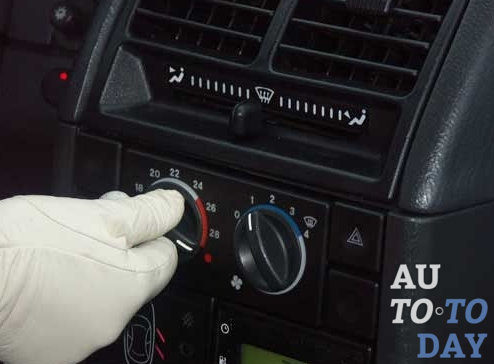 To check that the thermostat is working correctly, start the engine - let it run until the arrow of the temperature sensor starts to move. Feel the radiator pipes, the upper one should be warm, and the lower one should be cold. Further, the upper one should heat up more, and the lower one should remain cold. When the temperature reaches 80-90 degrees, the thermostat valve should open, and the lower branch pipe should heat up.
To check that the thermostat is working correctly, start the engine - let it run until the arrow of the temperature sensor starts to move. Feel the radiator pipes, the upper one should be warm, and the lower one should be cold. Further, the upper one should heat up more, and the lower one should remain cold. When the temperature reaches 80-90 degrees, the thermostat valve should open, and the lower branch pipe should heat up.
The performance of the pump must be checked by the noise level, the absence of traces of antifreeze on the oil seal, the absence of vibration due to the bearing on the pump shaft. If antifreeze flows, then air is sucked in somewhere and accumulates.
Remember! The main sign of the presence of air is an inoperative stove with a well-heated engine.
How to expel air from the cooling system, 3 ways
There are three ways to air the cooling system.
Method one
The sequence of actions is as follows:
- Remove the plastic shroud from the engine. To do this, unscrew the cap on the oil filling hole. Remove the cover. When the cover is removed, the cover can be replaced to prevent dust and dirt from entering the inside of the power unit.
- Find the nozzles responsible for warming up the throttle assembly.
- Pull off one of them.
- Twist the cap of the expansion tank hole (it contains antifreeze), cover the hole with a clean cloth.
- Blow inside the tank.
Second way
This method is simpler. You need to do the following:
- Warm up the engine for 10 - 15 minutes and turn it off.
- Leave the cap on the expansion tank closed.
- Remove one of the nozzles on the throttle assembly.
- Wait for antifreeze to come out of it.
- As soon as the antifreeze starts to come out, put the tube back in place and fix it very tightly with a clamp.
Remember! With this method, you need to be very careful, since antifreeze can heat up to 80 - 90 degrees.
Third way
This method is extremely simple, but very effective. Do the following:
- Climb a steep hill and stand with the front bumper taller than the rest of the car.
- Put the car on the handbrake, and put the inserts under the wheels so that the car does not go back.
- Unscrew the caps from the expansion tank and radiator.
- Let the machine warm up for 10-15 minutes.
- Periodically press the accelerator pedal while adding antifreeze to the tank.
Did you know? Many motorists divide antifreeze by color: they say, red antifreeze lasts 5 years, green - 3 years, and blue - 2 years. In fact, all coolants are transparent, dyes are added to them in order to make it easier to check the level of antifreeze in the tank. Antifreeze color is not an indicator of its "durability".
How to avoid airlock
Instead of thinking about how to remove an airlock from the cooling system, you need to avoid it. It is most correct to give the car to specialists, since air can accumulate in various places, and it is a professional who will be able to accurately determine the location of the traffic jam.
Try not to bring the engine to overheating, and the antifreeze to a boil. When boiled, antifreeze turns into steam, and it reaches the most inaccessible corners of the cooling system under pressure. It is at this point that the engine is most susceptible to damage.
Now you know how to expel air from the cooling system, what are the signs of this phenomenon and how to prevent it.
Subscribe to our feeds in
Cooling system automotive ICE designed to lower the temperature of working parts, oil, and gases that heat up during operation power unit... For most ICEs intended for installation on cars, a liquid cooling system is designed. In addition to its main purpose, this system performs a number of other functions:
- heats the air in the interior heating system
- cools the oil in the lubrication system of the entire engine and transmission
- lowers the temperature of the gas mixture in the exhaust gas recirculation system
One of the main components of the SOD is the radiator, because the circulation through it leads to a significant decrease in the temperature of the passing antifreeze or antifreeze, due to the flow of oncoming air. The tubular design of the radiator increases the efficiency of the cooling process many times over. The SOD also includes:
- a four-blade fan that rotates with an electric motor that turns on when the temperature of the antifreeze rises significantly. As a result of the fan operation, the air flow through the cooling radiator increases, and this air, receiving acceleration, lowers its temperature even before passing through the tubes of the device and, accordingly, increases the efficiency of the POD;
- a pump or pump is a working mechanism that pumps liquid through itself, setting it in motion in the right direction for normal, permanent work SOD, therefore, the system itself is called liquid, forced;
- a radiator of the heating system, antifreeze passing through its tubular body heats the air, which is sent to the cabin;
- expansion tank, it compensates for changes in the volume of antifreeze due to fluctuations in its temperature. In addition, through the expansion tank, additional fluid is poured into the system during its production;
- thermostat - regulates the circulation of the liquid along a large or small circuit depending on the temperature. A rather capricious device, often on a VAZ 2114 antifreeze must be drained due to its failure and the need to replace;
- tubes, nozzles and channels cut through the blocks through which the antifreeze is circulated;
- a coolant temperature sensor, with its help, the engine automatics performs a correction in its operation, and it also serves as a signaling device for the driver about the state of the vehicle.
How to bleed air from the engine cooling system of a VAZ 2114
Malfunctions occurring in the SOD can significantly ruin the life of the driver. For example, when an air lock forms in the cooling system, well-heated air ceases to flow into the passenger compartment due to the fact that antifreeze does not enter the heater stove. The engine is cooled worse, there is no normal heat exchange in the system. As a result, the entire internal combustion engine or individual units overheat, which reduces the resource of the power unit. The operation of some sensors is distorted, which also negatively affects the general condition of the car.
Why air locks form in the cooling system. There are several reasons:
- there is a leak in the system due to loose fittings. This happens more intensively in winter. At low temperatures, the plastic shrinks, and if you do not tighten the clamps in time, then a plug in the cooling system is provided;
- the valve on the expansion tank cap may be faulty;
- the tightness of the pump is broken;
- cracks or leaks appeared on the cooling or heating radiators;
- a breakdown of the cylinder head gasket was found.
More serious reasons are possible, such as:
- clogging of radiators or pipes, as well as some mechanical damage in them;
- deformation or breakage of the pump impeller;
- partial failure of the thermostat;
Before removing the airlock from the VAZ 2114 cooling system, it is necessary to carefully diagnose it for blockages, breakdowns and leaks. This must be done so that the work carried out then is not in vain. In addition, it is imperative to check the functionality of the thermostat. If it turns out to be completely or partially faulty, you can purify the system from air as much as you like, it will not work better.
Before starting work, you need to prepare antifreeze for adding to the system, if necessary. Also, rags and, preferably, two pairs of gloves - cotton, work and household, rubber. It is necessary to work with an aggressive liquid, especially heated to 80-90 degrees.
There are several options for how to expel air from the engine cooling system.
- An air lock forms at the top of the system. On the VAZ 2114, this is a throttle assembly. To get to it, you need to remove the cover that covers the engine from above. After that, one of the two pipes of the cooling system suitable for the remote control is disconnected. The clamp must be left on it so that later you can put it back on and seal it as soon as possible. Remove the cap from the expansion tank and, covering the neck with a thick rag, insert the pump and pressurize the tank to remove the air lock in the cooling system. After the antifreeze flows from the disconnected tube, you must quickly put it in place and fix it.
Some experts recommend blowing into the neck of the tank to squeeze out the antifreeze, but this cannot be done for two reasons. The main thing is that antifreeze or antifreeze is a toxic poison for the human body, and secondly, in order to blow effectively, you need to strain, and such "exercises" are useful to few people and can cause spasms.
- Another option for how to expel air from the cooling system of the VAZ 2114 is as follows.
Without removing the branch pipe from the throttle assembly, and without opening the cap of the expansion tank, warm up the engine well. After that, having previously put on gloves, disconnect the branch pipe from the remote control and allow the air to escape before the hot antifreeze is poured. Replace the tubing immediately and tighten securely.
- And the third option is how to bleed air from the cooling system on a VAZ 2114.
In this case, you need to take an assistant. The machine is placed on a flyover or hill with the front facing up. The radiator and expansion tank caps are unscrewed. After that, antifreeze is poured into the expansion tank to the top. The partner starts the engine and warms it up periodically by podgazovyvaya up to 3500 rpm. As necessary, antifreeze is added until air bubbles disappear. The lids are closed. The machine is now ready for use.
The cooling system of any engine consists of two circuits - main and small. When air appears in the antifreeze, the small circuit practically stops working. The stove does not heat, but, although it is necessary to get rid of the airlock. On injection engines, such as on the "Lada" VAZ-2114, it will be easy to expel air from the cooling system: the throttle assembly and access to it always remains open. There is also access to expansion tank, and nothing else is required.
If the tank is constantly inflating, this must also be dealt with. The video shows exactly how.
The 11183 engine has a plastic cover that can be removed by simply pulling the part up. You can first unscrew the oil filler cap.
Motor "11183" and its protective casing
The temperature regulator in the passenger compartment is moved to the right position. Without this, all actions will be useless.
Using method 1, the motor is first warmed up. For methods 2 and 3, the engine is left unheated.
Three different methods to expel air from the cooling system
Let's see how the throttle assembly on the 11183 motor works. Antifreeze goes through hoses 1 and 3, and hose 2 is a tube with air (do not touch).
Branch pipes on the throttle assembly VAZ-11183
Method 1 (remove the hoses on the throttle assembly)
If the engine has been warmed up, remove either of the two hoses by placing a container under it. May leak out 100-200 ml of liquid ... The hose is immediately returned to its place, the fastening is tightened, and the antifreeze is topped up through the neck of the tank. Here is "Method 1".
In “Method 1” operation, the tank is not first opened. You will need a Phillips screwdriver to loosen the clamp. All manipulations with hot antifreeze are carried out with caution.
Air usually comes out the first time. But, if the procedure is repeated, the plug can be removed completely.
Method 2 (tank stopper down)
The motor remains cold. We open the tank cap. Then we do it as in “method 1” (see photo).
Nozzles on the throttle assembly VAZ-2111
As you can see, the antifreeze does not flow out. Let's help him a little:
This method is universal. It is used on any car, including the VAZ-2114, and it is possible to expel air from the system immediately.
Method 3 (remove air without disassembling parts)
Let's consider the simplest way. You don't have to disassemble anything:
- We place the car on an overpass or hill so that the upper part of the radiator is higher than other parts;
- Opening the cover on the expansion tank;
- We start the engine. The system will warm up;
- Antifreeze level can drop abruptly. The liquid is then topped up.
The point is that a steam hose is connected to the radiator. Through it, air will escape into the tank.
Steam outlet on the tank (do not remove!)
It will be possible to increase the engine speed, but then make sure that antifreeze did not boil ... With the cover removed, this option is not excluded!
Two important points
Working according to method 1 or 2, the container is substituted both under the hose and under the nozzle of the throttle assembly. It is not known from which side the antifreeze will go first. The brand of liquid is chosen as follows:
- Antifreeze blue or green colour can be diluted with antifreeze of class G11 (green);
- Antifreeze of class G12 (but not G11) can be added to the red liquid.
Be careful: all antifreezes are usually sold as a concentrate!
Grade G11 fluid
Articles
- 21110-1008650-00 - plastic screen (only for 11183);
- 21120-1008658-00 - rubber screen pin;
- 21080-1311065-00 (-01, -03) - cork;
- 21080-1311067-00 - cork gasket.
Need only distillate?
We tried to expel air from the system, but on the VAZ-2114 the entire "plug" takes 100-150 ml. This means that nothing can be added to the tank at all. You can also add regular distilled water.
Distillate packs of 100 ml are easier to find at a pharmacy or battery store.

